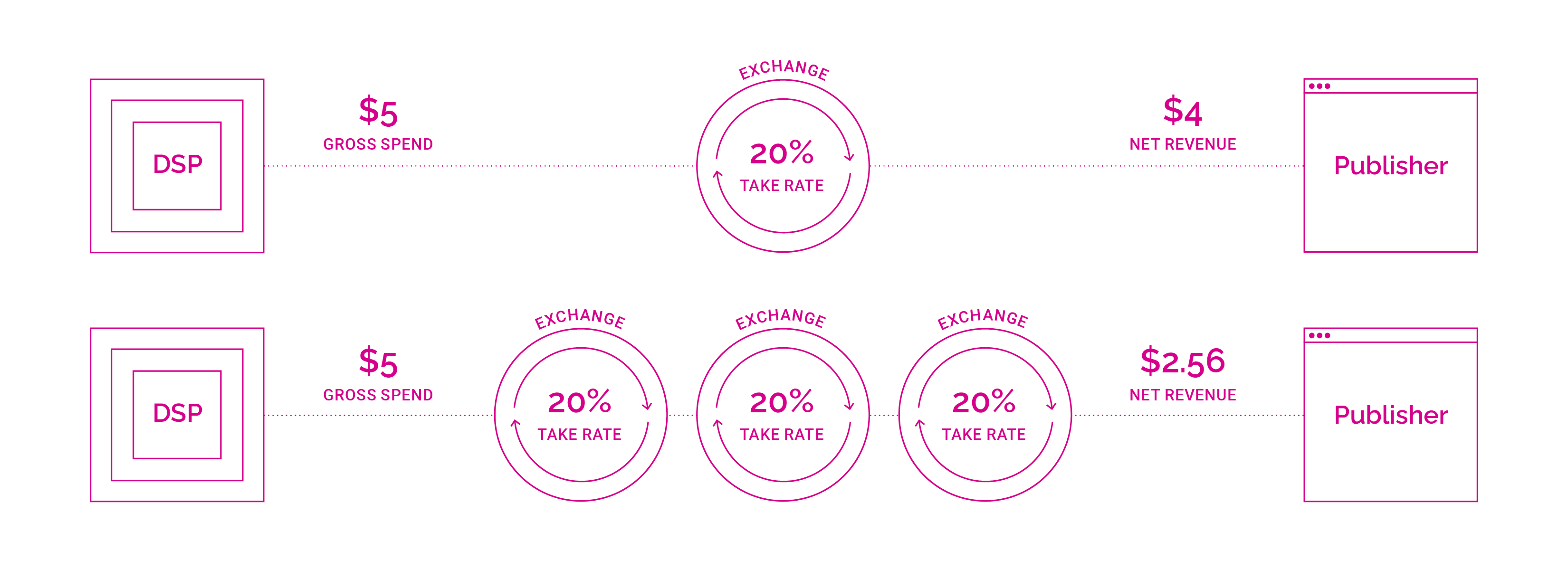Easily manage and organize your video library with a scalable solution built for streamlined control and delivery.

Prioritizing Demand Path Optimization
The programmatic landscape is often seen as complicated and lacking transparency. This complexity, coupled with the rise of numerous vendors touting various specialties, has resulted in the need for a more direct media sales path for publishers. Enter Demand Path Optimization (DPO)
DPO streamlines the way buyers connect with premium inventory through a more direct and transparent bidding process, reducing ad tech fees and increasing revenue for publishers.
Supply path optimization (SPO) has been widely adopted on the buy-side in an effort to maintain the value of working media, as it helps ad buyers identify the most efficient partnerships. SPO and DPO are two sides of the same coin, and it’s crucial that as buyers prioritize their SPO strategies, publishers follow suit to better understand and optimize how their inventory is being purchased.
As the industry navigates the challenges surrounding a potential recession and economic downturn, it will be beneficial for publishers to leverage the opportunity to capture more spend and build relationships with advertisers through DPO initiatives. To help publishers get a jump-start on prioritizing their DPO strategy, Connatix crafted "A Publisher’s Guide to Demand Path Optimization". Here is a preview of what you'll find in the e-book!
Breaking down DPO
Demand Path Optimization refers to the process of assessing and refining the way advertisers buy publisher inventory in an effort to grow publisher revenue and increase ROAS through a simplified supply path. Without a clear understanding and audit of every partner’s supply path, publishers’ monetization efforts can be greatly depleted by ad tech middlemen. With every additional hop, an intermediary takes a fee and by the time it reaches the publisher, the CPM has been greatly reduced.
Understanding our key players
DPO is gaining importance as publishers audit their supply chains and while most publishers understand that a messy supply chain means more fees and less money, there are a few misconceptions around DPO (beyond fees) that impact publisher revenue, and it all starts with breaking down our key players.
One of the main reasons for the highly complicated nature of programmatic advertising is the number of players involved, from publishers to advertisers, agencies, DSPs, SSPs, resellers, ad exchanges, networks, DMPs and more. It’s critical to understand how each player works with one another and the value they bring in order to ensure you have full transparency.
To remove middlemen that have historically created unnecessary costs and inefficiencies for all parties, Connatix offers direct connections to the top leading DSPs including The Trade Desk, and most recently Google's Display & Video 360. As a result, brands are now directly optimizing their paths to the inventory they want to win and driving more efficient, high-impact video advertising at scale. Publishers are also unlocking greater ad spend as they help brands directly discover the best inventory quickly and easily.
“Understanding how our inventory is being purchased brought to light inefficiencies in our demand paths. Prioritizing partners that bring us the most value has not only strengthened our monetization efforts but also our relationships with advertisers,” said Ryan Molly, Sr. Director of Programmatic & Video Operations at Vox Media."
Given the abundance of intermediaries involved, knowing where fees are applied and uncovering hidden ones is the first step in the DPO process. Some intermediaries provide a fair value exchange for services or technology, while others don’t, or worse yet, their fees are hidden entirely. Conducting a demand path audit will give visibility into your partners’ fee structures to assess what’s bringing substantial value and what is acting as a cost center. In this simplified visual see how the key players work together and where fees are typically applied.

Unlocking increased revenue with DPO
As the media landscape continues to evolve throughout 2023 and we continue to prepare for a potential recession, it’s important to have a fluid DPO strategy in place to make the most of your revenue dollars. With an understanding of who the key players are and the fees associated, let’s dig further into the advantages that a strong DPO strategy can bring.
1. Fewer transaction fees
Every added hop in the media-supply chain adds a fee. By evaluating current fee structures and consolidating demand partners to those with the most transparent purchase path, publishers can grow revenue while cutting costs.
2. Increased transparency = more valuable inventory
Buyers are less likely to purchase inventory only accessible through messy supply chains. To unlock the most value for your inventory and provide advertisers with the transparency they need, it’s important to work with demand partners that can offer efficient supply paths. Doing so will help increase both the quantity of bids and the overall average spend per deal.
3. Ensure every impression opportunity is seen by a potential buyer
Every platform has their own SPO strategies and algorithms to ensure they are maximizing spend efficiently. Additionally, platforms have their own approval policies and may not allow your inventory for a host of reasons (e.g, various quality assurance vendors, ads.txt authorization, etc). For publishers, that means irrespective of individual buyers’ SPO paths, your inventory may be filtered out if it doesn’t meet certain SPO benchmarks or policies set by DSPs. By collapsing the supply chain, you reduce the risk of your inventory being inaccessible due to buy-side SPO filtering.
4. Building recognition as a premium supply partner
Advertisers heavily leaned into SPO are looking for partners who make it easy to buy premium inventory with fewer supply chain hops and the greatest ROAS. With RTB-enabled publishers monetizing through 28 SSPs on average along with additional resellers, an opportunity exists for publishers who remove inefficient paths. By investing in DPO, publishers (and their designated demand partners) become trusted suppliers of premium, efficient media and increase the likelihood of repeat buying.
In a 2022 Q4 report by Deloitte, CFOs said their top-three priorities are cost management (52%), financial performance (50%), and growth (38%). Publishers know that an ad recession is on its way, and action is required now. Ready to get started? Check out our Publisher’s Guide to Demand Path Optimization to learn more about how a strong DPO strategy can help you generate more revenue dollars.


